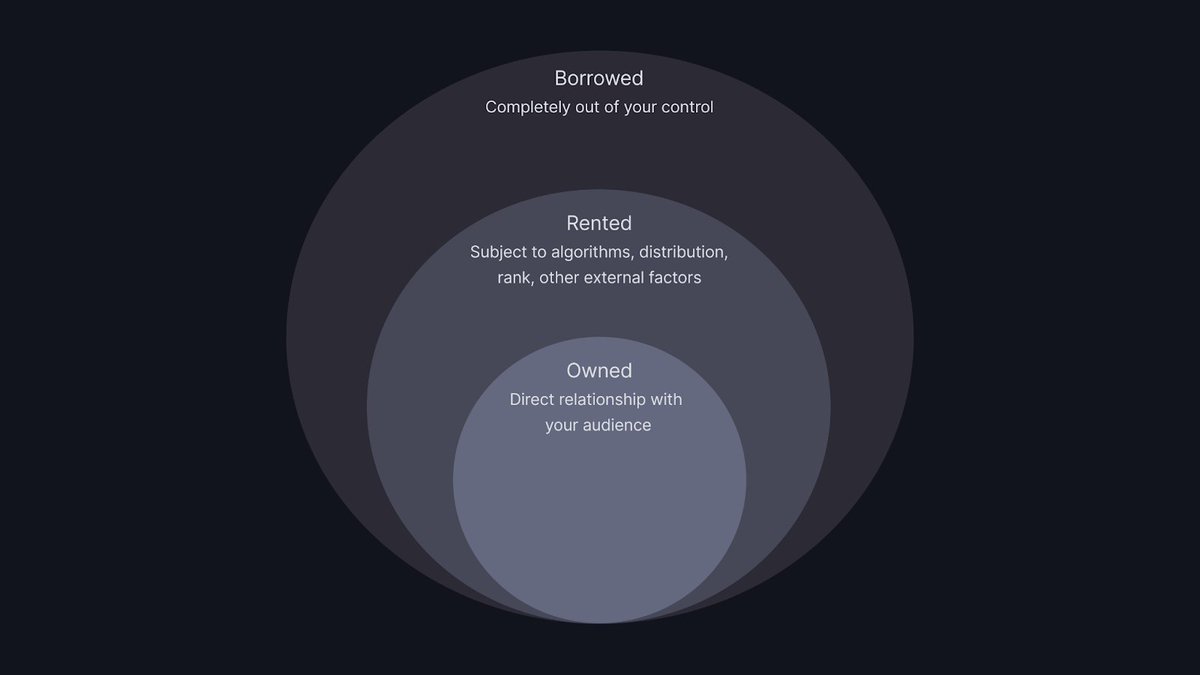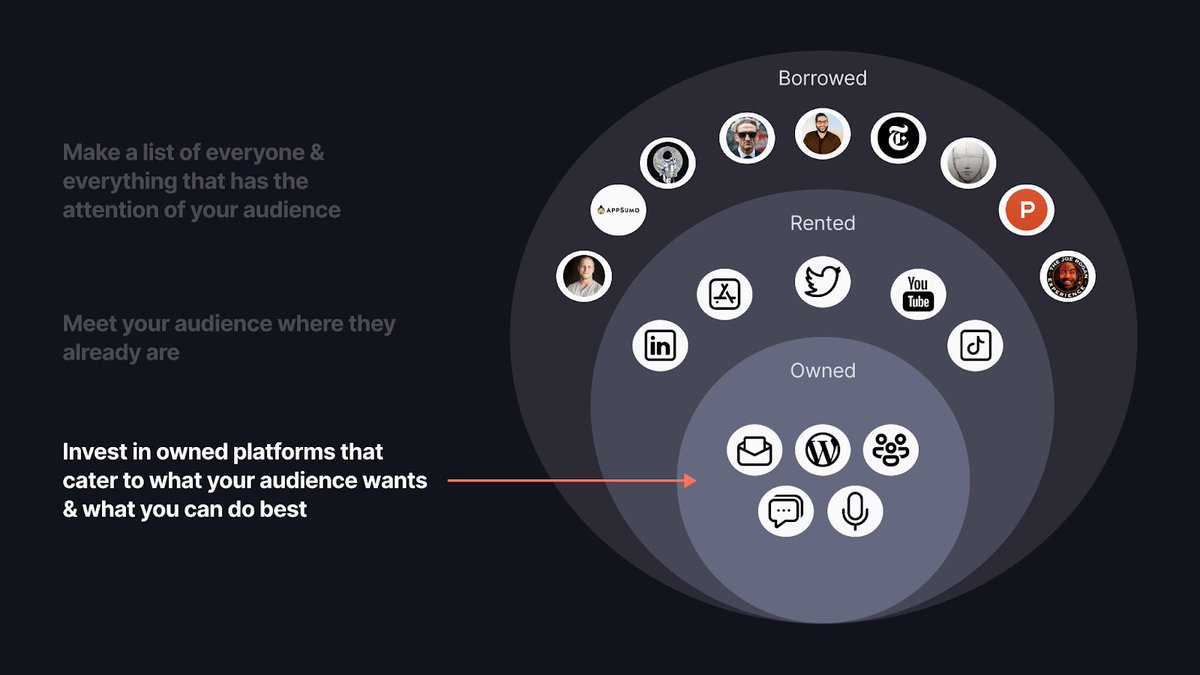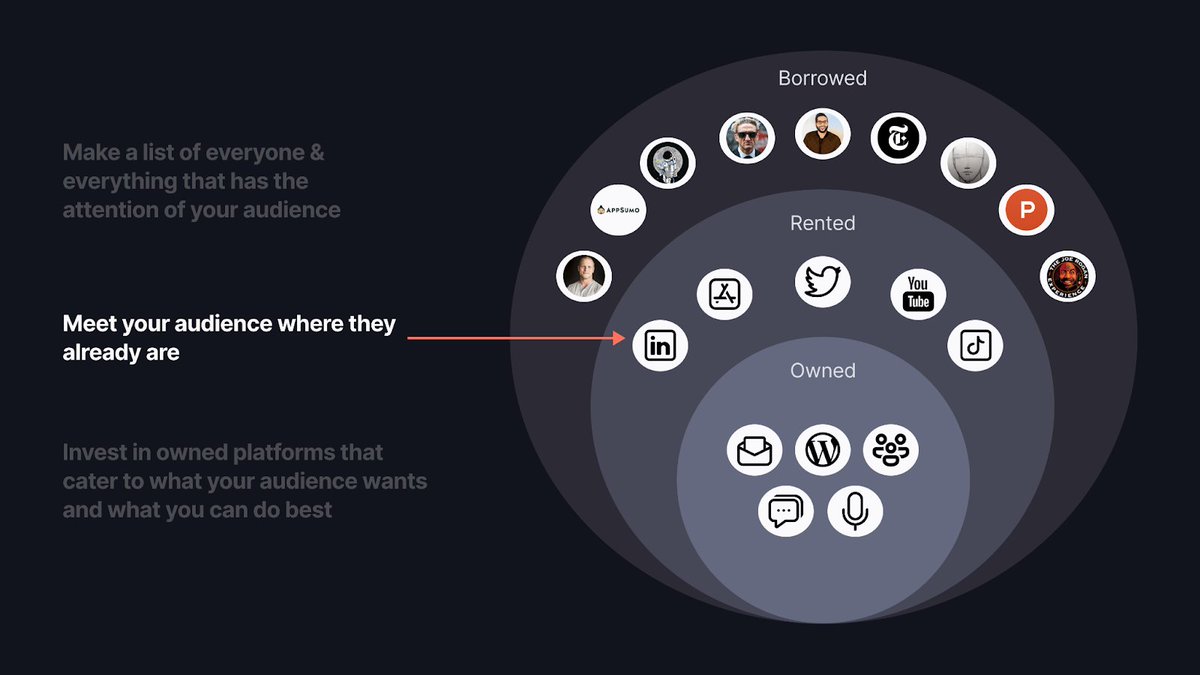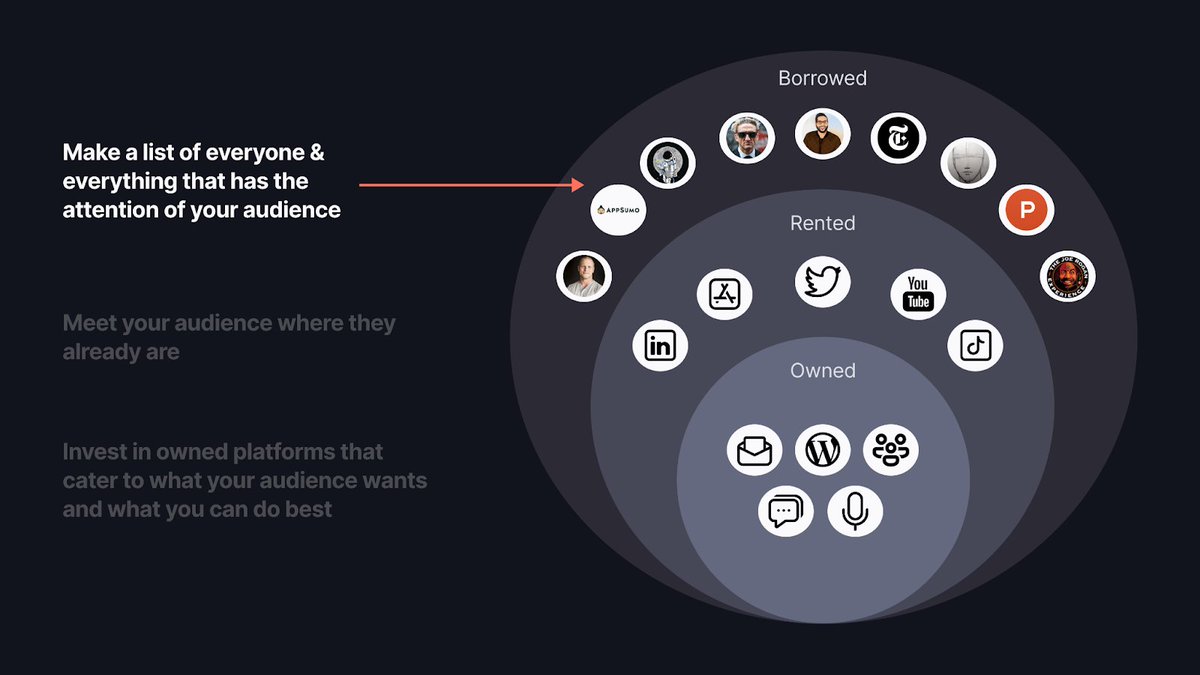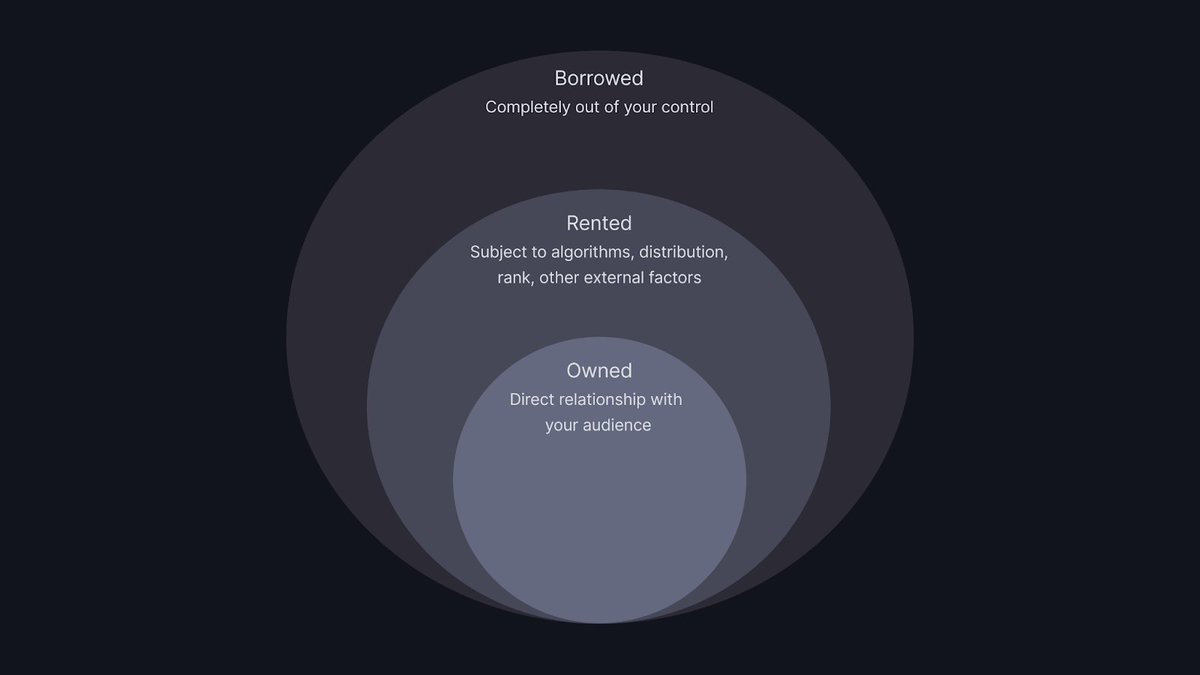The ORB Framework
I& #39;ve found that marketing strategies and tactics can be broken down into three main categories: Owned, Rented, and Borrowed platforms.
Here& #39;s how it can help you craft your marketing plan and continually build an audience. https://abs.twimg.com/emoji/v2/... draggable="false" alt="🧵" title="Thread" aria-label="Emoji: Thread">
https://abs.twimg.com/emoji/v2/... draggable="false" alt="🧵" title="Thread" aria-label="Emoji: Thread">
I& #39;ve found that marketing strategies and tactics can be broken down into three main categories: Owned, Rented, and Borrowed platforms.
Here& #39;s how it can help you craft your marketing plan and continually build an audience.
There& #39;s an endless amount of strategies and tactics available today.
Newsletter referral program, blog posts, programmatic SEO, PR stunts, engineering-as-marketing, TikTok... the list goes on and on.
How do you choose what to do?
This is where the ORB framework comes in.
Newsletter referral program, blog posts, programmatic SEO, PR stunts, engineering-as-marketing, TikTok... the list goes on and on.
How do you choose what to do?
This is where the ORB framework comes in.
Think of every marketing strategy and tactic as a line of communication with your intended audience.
You can either own, rent, or borrow that line of communication.
I& #39;ll explain the definitions and nuances of each.
You can either own, rent, or borrow that line of communication.
I& #39;ll explain the definitions and nuances of each.
The concentric circles are meant to represent the level of depth you have with the audience.
At the core, you’re as close to your audience as you can be. It’s a private medium.
As you expand outward, you reach more people, but the level of depth and connection is reduced.
At the core, you’re as close to your audience as you can be. It’s a private medium.
As you expand outward, you reach more people, but the level of depth and connection is reduced.
Owned: Direct relationship with your audience (e.g. newsletter, community, podcast)
Rented: Subject to algorithms & distribution mechanisms (e.g. Twitter, YouTube, app store listing)
Borrowed: Leveraging someone else& #39;s owned/rented platform (e.g. guest post, conference keynote)
Rented: Subject to algorithms & distribution mechanisms (e.g. Twitter, YouTube, app store listing)
Borrowed: Leveraging someone else& #39;s owned/rented platform (e.g. guest post, conference keynote)
When you lay out all your marketing experiments and channels, everything should point back to your owned platforms.
Borrowing someone else’s audience is all for naught if you can’t lead them back to a rented or owned platform.
This is traditionally also known as a "funnel."
Borrowing someone else’s audience is all for naught if you can’t lead them back to a rented or owned platform.
This is traditionally also known as a "funnel."
OWNED Platforms
Communication lines where you have a direct relationship with your audience.
It& #39;s important to note that you don& #39;t own your audience, you own the line of communication.
Communication lines where you have a direct relationship with your audience.
It& #39;s important to note that you don& #39;t own your audience, you own the line of communication.
Ask any successful creator or brand what their most successful marketing channel is and they& #39;ll probably name one of the owned platforms: blog, email, community, podcast, or text message list.
This is no coincidence.
Own the line of communication = More efficient marketing.
This is no coincidence.
Own the line of communication = More efficient marketing.
Owned platforms give you more control, more reach, and more predictability.
Naturally, owned platforms get more effective over time whereas borrowed and rented platforms usually get less effective over time.
Naturally, owned platforms get more effective over time whereas borrowed and rented platforms usually get less effective over time.
Which of the owned platforms should you invest in?
Find the intersection between what you love doing and what your audience wants.
Find the intersection between what you love doing and what your audience wants.
You don’t have to have a blog, a newsletter, a community, a podcast, AND and text message list.
You could, and maybe you eventually do that, but focus first on the one to two that best align with what you can deliver on and what your audience is craving.
You could, and maybe you eventually do that, but focus first on the one to two that best align with what you can deliver on and what your audience is craving.
If your industry is lacking quality blog content, then blog.
If you think you can create your audience’s next favorite podcast, then podcast.
If there& #39;s a gap in video content, YouTube.
And so on.
If you think you can create your audience’s next favorite podcast, then podcast.
If there& #39;s a gap in video content, YouTube.
And so on.
Owned platforms aren’t sexy. They’ve been around forever.
But that’s also why they’re here to stay.
The Lindy Effect: The longer something has been around, the more likely it is to keep sticking around. https://twitter.com/SahilBloom/status/1331634650368929798?s=20">https://twitter.com/SahilBloo...
But that’s also why they’re here to stay.
The Lindy Effect: The longer something has been around, the more likely it is to keep sticking around. https://twitter.com/SahilBloom/status/1331634650368929798?s=20">https://twitter.com/SahilBloo...
Blogs are here to stay.
People and companies will continue to build out their website with valuable information and resources.
Your website is your homebase.
People and companies will continue to build out their website with valuable information and resources.
Your website is your homebase.
Newsletters are here to stay.
Email is a fundamental identity and communication asset to everyone on the internet.
It& #39;s proven to be the most effective marketing channel dollar for dollar.
Email is a fundamental identity and communication asset to everyone on the internet.
It& #39;s proven to be the most effective marketing channel dollar for dollar.
Communities are just getting started, but the sky& #39;s the limit.
Communities are the ultimate owned platform as you determine who gets to be a part of it, what information is shared, and how members communicate.
You can carve out your own little corner of the internet.
Communities are the ultimate owned platform as you determine who gets to be a part of it, what information is shared, and how members communicate.
You can carve out your own little corner of the internet.
Podcasts are built on RSS, one of the oldest and most fundamental technologies to the internet.
While many details like downloads and subscribers are left ambiguous, you still have a direct line of communication with your audience to receive your content.
While many details like downloads and subscribers are left ambiguous, you still have a direct line of communication with your audience to receive your content.
Texting is the most intimate form of communication on the list of owned platforms.
Usually reserved for friends and family to chat, it’s being used more and more to receive updates, communicate with others in a group or 1:1 setting, and subscribe to content.
Use it wisely.
Usually reserved for friends and family to chat, it’s being used more and more to receive updates, communicate with others in a group or 1:1 setting, and subscribe to content.
Use it wisely.
Video is an emerging owned platform thanks to technology like @wistia Channels which allow you to turn your website into a video destination for your audience.
You can embed videos and playlists directly on your site.
It’s like creating your own Netflix.
You can embed videos and playlists directly on your site.
It’s like creating your own Netflix.
Rented platforms include:
• Facebook
• Instagram
• Twitter
• LinkedIn
• Snapchat
• YouTube
• TikTok
• Quora
• Reddit
• Pinterest
• Medium
• Snapchat
• YouTube
• TikTok
• Quora
• Medium
Rented platforms also include:
• Mobile app stores: Apple App Store & Google Play
• Browser extensions: Chrome, Safari, and Firefox
• SaaS platform plugins: Shopify, Salesforce, HubSpot, Intercom, Figma, Intuit
• Messenging apps: WhatsApp, WeChat, Messenger, Telegram
• Mobile app stores: Apple App Store & Google Play
• Browser extensions: Chrome, Safari, and Firefox
• SaaS platform plugins: Shopify, Salesforce, HubSpot, Intercom, Figma, Intuit
• Messenging apps: WhatsApp, WeChat, Messenger, Telegram
Here& #39;s an analogy:
When you rent a home, you have the right to live there and you can call it yours. But you can’t make major exterior or interior changes, you have to live by the rules that the landlord, and everything is subject to change. Next year, rent could go up. https://abs.twimg.com/emoji/v2/... draggable="false" alt="🤷♂️" title="Achselzuckender Mann" aria-label="Emoji: Achselzuckender Mann">
https://abs.twimg.com/emoji/v2/... draggable="false" alt="🤷♂️" title="Achselzuckender Mann" aria-label="Emoji: Achselzuckender Mann">
When you rent a home, you have the right to live there and you can call it yours. But you can’t make major exterior or interior changes, you have to live by the rules that the landlord, and everything is subject to change. Next year, rent could go up.
Rented platforms control the end user& #39;s entire experience.
You have to "play the game."
Algorithms, monetization, reach, discovery, profiles.
It’s all about tradeoffs.
You have to "play the game."
Algorithms, monetization, reach, discovery, profiles.
It’s all about tradeoffs.
Downside #1: Reduced reach
Facebook had amazing organic reach… until it didn’t.
From 2012 – 2016, organic reach dropped from 16% to 2%. Yikes.
This could happen on any platform, not just Facebook.
Facebook had amazing organic reach… until it didn’t.
From 2012 – 2016, organic reach dropped from 16% to 2%. Yikes.
This could happen on any platform, not just Facebook.
Downside #2: Ambiguous algorithms
Platforms change and tweak what gets shown in a feed all the time.
When Facebook launched support for videos, video content got favored in the feed algorithm.
These distribution mechanisms can change on a dime.
Platforms change and tweak what gets shown in a feed all the time.
When Facebook launched support for videos, video content got favored in the feed algorithm.
These distribution mechanisms can change on a dime.
Downside #3: Censorship
We saw this with a certain world leader who rhymes with krump.
We see it with NSFW content, marijuana and cannabis-related content, and many other categories. Rules are rules.
We saw this with a certain world leader who rhymes with krump.
We see it with NSFW content, marijuana and cannabis-related content, and many other categories. Rules are rules.
Downside #4: Pay-to-play
Want to reach the right people on the platform? You’ll have to run an ad that’ll cost you for every click.
Want to reach the right people on the platform? You’ll have to run an ad that’ll cost you for every click.
Downside #5: Ephemeral content
Tweets and posts carry far less weight than a newsletter or comment in a community.
Tweets and posts carry far less weight than a newsletter or comment in a community.
Upside #1: Discoverability
TikTok is known for its “For You Page” which curates new content based on what you like.
YouTube is the second largest global search engine and is known for its recommendation sidebar.
Apple App Store ranks you based on installs, ratings, & growth.
TikTok is known for its “For You Page” which curates new content based on what you like.
YouTube is the second largest global search engine and is known for its recommendation sidebar.
Apple App Store ranks you based on installs, ratings, & growth.
Upside #2: Shareability
Virality is in the nature of many social networks.
A retweet by an account with a large following gets you in front of a sizable portion of their audience.
Virality is in the nature of many social networks.
A retweet by an account with a large following gets you in front of a sizable portion of their audience.
Upside #3: It& #39;s where people naturally consume content
People spend an enormous amount of time on social platforms.
4 billion people use social media today, which accounts for ~51% of the global population.
On average, global internet users spent ~2.5 hrs/day on social media.
People spend an enormous amount of time on social platforms.
4 billion people use social media today, which accounts for ~51% of the global population.
On average, global internet users spent ~2.5 hrs/day on social media.
Meet your audience where they already are.
Commit to a few — you don& #39;t have to have a strategy for every single rented platform.
In fact, you could even just commit to one.
For me, it& #39;s Twitter. (surprise https://abs.twimg.com/emoji/v2/... draggable="false" alt="😆" title="Lächelndes Gesicht mit geöffnetem Mund und fest verschlossenen Augen" aria-label="Emoji: Lächelndes Gesicht mit geöffnetem Mund und fest verschlossenen Augen">)
https://abs.twimg.com/emoji/v2/... draggable="false" alt="😆" title="Lächelndes Gesicht mit geöffnetem Mund und fest verschlossenen Augen" aria-label="Emoji: Lächelndes Gesicht mit geöffnetem Mund und fest verschlossenen Augen">)
For others, YouTube is their main thing. For others, Instagram.
Commit to a few — you don& #39;t have to have a strategy for every single rented platform.
In fact, you could even just commit to one.
For me, it& #39;s Twitter. (surprise
For others, YouTube is their main thing. For others, Instagram.
Publishing on owned and rented platforms without an existing audience is like speaking into the void.
It’s a chicken or egg scenario.
In order to grow your audience, you need people to share your content.
But what do you do if no one is there to share your content?
It’s a chicken or egg scenario.
In order to grow your audience, you need people to share your content.
But what do you do if no one is there to share your content?
What does borrowing someone’s audience look like practically?
Guest posting on a popular blog, YouTubers doing a “collab” together, Instagram shoutouts, even speaking at conferences.
It’s when you get exposure to someone else& #39;s audience.
Guest posting on a popular blog, YouTubers doing a “collab” together, Instagram shoutouts, even speaking at conferences.
It’s when you get exposure to someone else& #39;s audience.
Borrowing other people& #39;s audience is a drastically overlooked strategy.
Most people adopt a passive approach to borrowed platforms.
They wait for others to reach out to them and make the first move to do some sort of collaboration.
Most people adopt a passive approach to borrowed platforms.
They wait for others to reach out to them and make the first move to do some sort of collaboration.
Just taking inbound collaboration requests can work if you’re already someone notable and sought out to collaborate with.
But either way, doing anything passively isn’t much of a strategy.
Progress takes intention.
But either way, doing anything passively isn’t much of a strategy.
Progress takes intention.
The magic of borrowing other people’s audiences is that they’ve already done all the hard work for you.
They’ve attracted the right people, earned their trust, and kept their attention over time.
Now all you have to do is show up and provide something valuable.
They’ve attracted the right people, earned their trust, and kept their attention over time.
Now all you have to do is show up and provide something valuable.
Instead of waiting for your newsletter to grow into a massive channel, imagine doing a “takeover” where you get to write for a newsletter with 50,000+ subscribers?
Or instead of waiting for your channel to grow, imagine doing a collab with a YouTuber with 1M+ subscribers?
Or instead of waiting for your channel to grow, imagine doing a collab with a YouTuber with 1M+ subscribers?
Borrowed platforms can provide an instant boost.
A step-change.
It can kickstart and accelerate your growth to new levels.
A step-change.
It can kickstart and accelerate your growth to new levels.
Strategies to effectively borrow someone else’s audience can roughly be summed up as:
1. Make a list of everyone and everything that has the attention of your intended audience.
2. Work out a win-win collaboration as a guest, partner, participant, source, or sponsor.
1. Make a list of everyone and everything that has the attention of your intended audience.
2. Work out a win-win collaboration as a guest, partner, participant, source, or sponsor.
The easiest way to start mining information about who has the attention of your audience is to… ask your audience!
Ask these questions in a survey or call:
• Which social platforms are you on?
• Who do you pay attention to?
• What blogs, podcasts, or newsletters do you subscribe to?
• What publications, magazines, or news outlets do you subscribe to?
• Where do you find new content?
• Which social platforms are you on?
• Who do you pay attention to?
• What blogs, podcasts, or newsletters do you subscribe to?
• What publications, magazines, or news outlets do you subscribe to?
• Where do you find new content?
Since borrowed platforms are completely contextual to the audience you’re trying to reach, there will never be a plug-and-play list.
You have to create your own, from scratch, based on who your audience is and who they pay attention to.
It’s more art than science here.
You have to create your own, from scratch, based on who your audience is and who they pay attention to.
It’s more art than science here.
Here& #39;s the blog post to reference later: https://www.swipefiles.com/articles/orb ">https://www.swipefiles.com/articles/...
I always feel silly saying this but  https://abs.twimg.com/emoji/v2/... draggable="false" alt="🤷♂️" title="Achselzuckender Mann" aria-label="Emoji: Achselzuckender Mann">
https://abs.twimg.com/emoji/v2/... draggable="false" alt="🤷♂️" title="Achselzuckender Mann" aria-label="Emoji: Achselzuckender Mann">
If you enjoyed this thread, hit the follow button for more on marketing, growth, and persuasion.
I also send an occasional newsletter on cutting-edge, comprehensive, and sometimes even crazy marketing ideas. http://swipefiles.com"> http://swipefiles.com
If you enjoyed this thread, hit the follow button for more on marketing, growth, and persuasion.
I also send an occasional newsletter on cutting-edge, comprehensive, and sometimes even crazy marketing ideas. http://swipefiles.com"> http://swipefiles.com
TLDR:
Owned platforms are the priority — this is where you have a direct relationship with your audience.
Rented platforms offer discoverability and interaction, but come with platform risk.
Borrowed platforms allow you to leverage other people& #39;s owned and rented platforms.
Owned platforms are the priority — this is where you have a direct relationship with your audience.
Rented platforms offer discoverability and interaction, but come with platform risk.
Borrowed platforms allow you to leverage other people& #39;s owned and rented platforms.

 Read on Twitter
Read on Twitter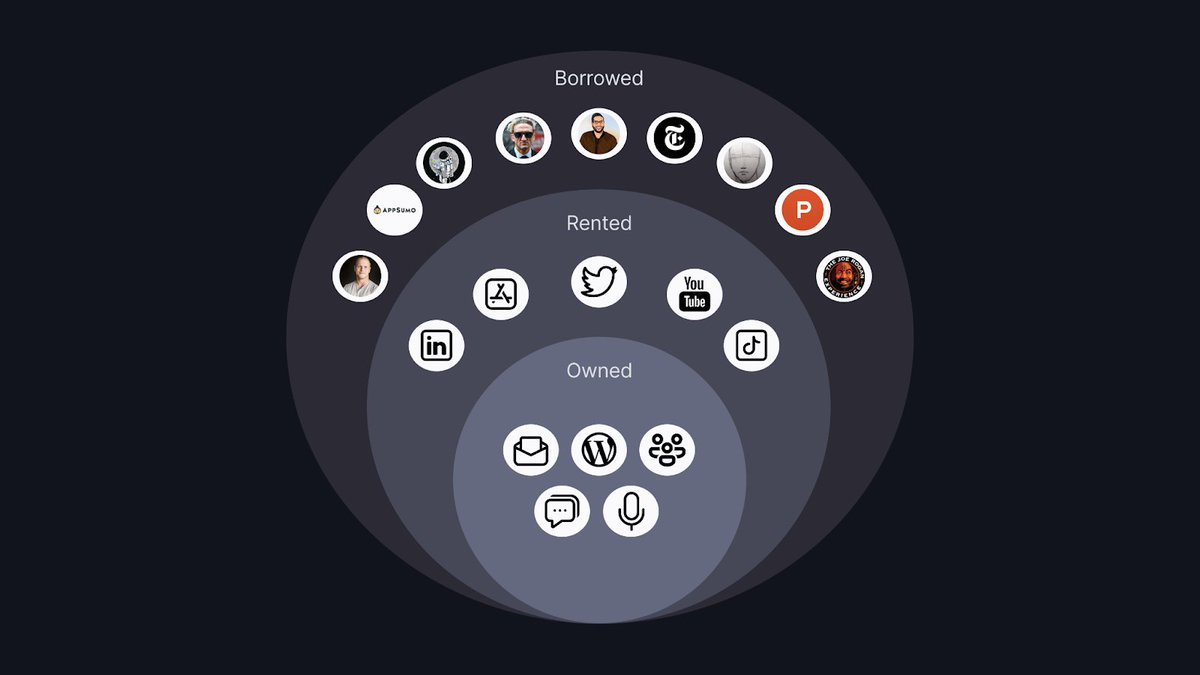 " title="The ORB FrameworkI& #39;ve found that marketing strategies and tactics can be broken down into three main categories: Owned, Rented, and Borrowed platforms.Here& #39;s how it can help you craft your marketing plan and continually build an audience. https://abs.twimg.com/emoji/v2/... draggable="false" alt="🧵" title="Thread" aria-label="Emoji: Thread">" class="img-responsive" style="max-width:100%;"/>
" title="The ORB FrameworkI& #39;ve found that marketing strategies and tactics can be broken down into three main categories: Owned, Rented, and Borrowed platforms.Here& #39;s how it can help you craft your marketing plan and continually build an audience. https://abs.twimg.com/emoji/v2/... draggable="false" alt="🧵" title="Thread" aria-label="Emoji: Thread">" class="img-responsive" style="max-width:100%;"/>
